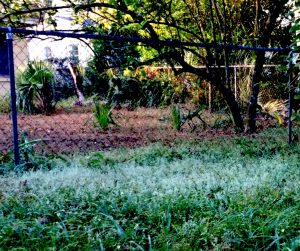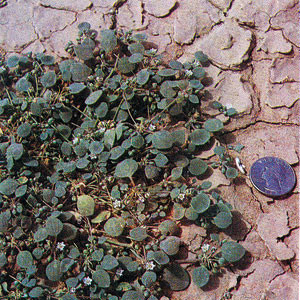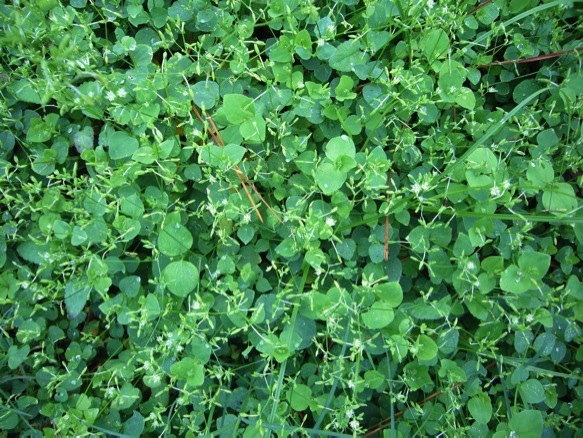Drymaria cordata: Kissing cousin chickweed
Drymaria cordata is one of those plants that confounds the mind. You know what it resembles: Chickweed. It has one of the main characteristic of chickweed, an elastic inner core. However it ain’t your usual chickweed, but it is a kissing cousin. It reminds you that plants are in families for a reason and they do look alike as many family members do.
D. cordata’s growth habit closely resembles chickweed (Stellaria) but the leaves are wrong, there is no fine line of hair on the stem, and the leaves do not taste like raw corn. Nonetheless. your mind, that great pattern finder, says this is chickweed.

West Indian Chickweed can indeed look like snow.
Were it not for the fact it surrounded my tangerine tree years ago I would have never paid much attention to it. Drymaria cordata (dry-MAIR-ri-ah core-DAY-ta) is one of the few edibles that is not mentioned in virtually any of my 100-plus books on foraging. There is also the issue of what to call it: Drymary, Heartleaf Drymary, Whitesnow, Tropical Chickweed, West Indian Chickweed. It also has a second scientific name Drymaria diandra, though some list that as a subspecies or a variety and it has many herbal uses. And the genus name is no help. Drymaria comes from the Greek word drymos (dreeMOS) meaning forest. The D. cordata does not grow in the forest, but apparently some relative did thus the name. Cordata helps. The leaves are roughly heart shaped. Diandra is Greek and means twice the man, or two men. It does not mean “Diana” as a lot of baby name books say. There is no linguistic justification for that. To say Diandra is Greek for Diana is to ignore that the Greek name for Diana is Artemis, and that diandra literally does mean two men. To go from two men to a goddess is a bit of a leap. However what diandra means referring to the plant is a good guess. In botany diandra usually means two stamens. The cordata has three stamens.
Unlike its relative chickweed, Stellaria, only the leaves and young shoots of the D. cordata are eaten. They are also ground, boiled, then the water filtered and the water used for a variety of medicinal issues. Science has confirmed it has some interesting properties. See the Herb Blurb below. Drymaria cordata also invades 31 commercial crops in 45 countries.
Mild in flavor, raw leaves can be added to salad or other dishes. You can also cook them. As they are used in several herbal applications I suggest you don’t over do them in one meal, particularly raw. Also, Drymaria gracilis is edible as well but…

Inkweed, Drymaria pachyphylla is toxic. Photo by New Mexico State University.
One other thing: It has a relative, Drymaria pachyphylla (dry-MAiR-ee-a pak-ee-FIL-uh) also called the Thick Leaf Drymaria. It is poisonous. Fortunately it looks a lot different, usually growing in a small rosette just a few inches across. It’s native range is Texas through the southwest. It often poisons livestock. Avoid it.
Green Deane’s “Itemized” Plant Profile
IDENTIFICATION: D. cordata: Annual herb with slender, smooth stems to about a foot long, frequently rooting at the nodes. Leaves roughly heart shaped, opposite, very short stems. Veins in leaf palmate from the base (the veins go out like five fingers from the bottom end of the leaf, clearly seen on the underside.) Flowers on long stalks; 5 sepals, petal 5, deeply 2-lobed, shorter than the sepal, white; 3 stamen, style divided into three below the middle. Does NOT have milky sap. If you have a plant you think is chickweed and it has milky sap you have the wrong plant
TIME OF YEAR: During the cool weather in warm climates, spring and summer in more temperate climates. Far more distributed around the world them most official maps show, Florida to Nepal to Africa.
ENVIRONMENT: Likes sun and moist soil, a pesky weed to cultivated areas and lawns around the world.
METHOD OF PREPARATION:Leaves usually used raw in salads. Has a tender, mild flavor. As it is also an herbal medication, don’t eat a truck load at a time. (Also see chickweed elsewhere on this site.)
HERB BLURB
Abstract:
Different extracts of Drymaria cordata Willd (aerial parts) were tested for antibacterial efficacy against Staphylococcus aureus ATCC 29737, Escherichia coli ATCC 10536, Bacillus subtilis ATCC 6633, Bacillus pumilis ATCC 14884 and Pseudomonas aeruginosa ATCC 25619. The effects produced by the extracts were found to have significant activities against all the organisms being tested and the effects so produced were compared with those of chloramphenicol. The methanol extract was found to be the most effective.
Abstract:
The methanol extract of Drymaria cordata Willd, was investigated for its effect on a cough model induced by sulfur dioxide gas in mice. It exhibited significant antitussive activity when compared with the control in a dose-dependent manner. The antitussive activity of the extract was comparable to that of codeine phosphate, a prototype antitussive agent. The D. cordata extract (100, 200, 400 mg/kg) showed 11.6%, 31.6% and 51.5% inhibition of cough with respect to the control group.
Abstract
A novel anti-HIV alkaloid, drymaritin (1), and a new C-glycoside flavonoid, diandraflavone (2), along with eight known compounds, torosaflavone A, isovitexin, spinasterol β-D-glycoside, p-hydroxybenzoic acid, p-hydroxybenzaldehyde, cis-p-coumarate, methyl 5-hydroxy-4-oxopentanoate, and glycerol-α-lignocerate, were isolated from Drymaria diandra. Drymaritin (1) exhibited anti-HIV effects in H9 lymphocytes with an EC50 value of 0.699 μg/mL and a TI of 20.6. Compound 2 showed significantly selective inhibition on superoxide anion generation from human neutrophils stimulated by fMLP/CB with an IC50 value of 10.0 μg/mL.


